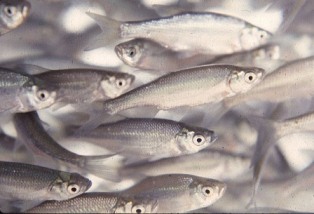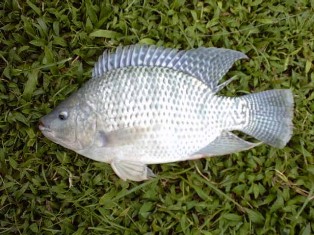Feed frequency is based on fish size and how quickly fish consume feed. When small trout are started on feed, they should be fed small amounts at frequent intervals. As fish grow larger, the frequency of daily feedings deceases. A general rule of thumb is to feed 1% of body weight per feeding and to adjust feed frequency to obtain the desired feeding percentage to ensure all fish have access to feed. Thus, if fish are being fed 4% of …
How does one count trout eggs?
Several methods can be used to count eyed trout eggs. These include measuring volume, displacement, or weight; counting the number of eggs in a V-trough (Von Bayer method); or using electronic egg counters. Many trout farmers use the displacement method to estimate egg volume because it is relatively fast, simple, accurate, and does not require much equipment. The numbers of eggs per unit of volume can be estimated by counting 50 eggs into 25 ml of water in a 50-ml …
Largemouth Bass
Robert Durborow, State Extension Specialist for Aquaculture, Kentucky State University

Adult largemouth bass. Photo: Dr. Rusty Wright, Auburn University.
Largemouth bass (LMB) are cultured for food fish and pond stocking. They can bring prices as high at $6.00 per pound (live weight) for the grower and can be grown at a wide range of temperatures. Some states (e.g., New York and Mississippi) prohibit LMB sales (probably because they believe that sales would encourage illegal capture and sale of wild bass), …
Catfish Farm Management
Overview of Financial Management Training Modules (ppt).
Financial Management on Catfish Farms to Impprove Effieciencis and Porfitability
Balance Sheets: Tools for Improving Finacial Position in the Catfish Business
Balance Sheets: a Management Tool to Improve Financial Position of the Business (ppt).
Using Balance Sheets to Improve the Business’s Financial Position (ppt).
Profitability: Enterprise Budgets and Income Statements to Improve
…Pond Culture
Culturing Fish in Ponds
Vanessa Weldon, Extension Associate, University of Arkansas at Pine Bluff
Pond culture is a very popular aquaculture production method with many aquatic species cultured in ponds. To have successful pond production, ponds must be properly sited and built, with careful assessment of water availability, quantity, and quality. There are two main types of pond systems: watershed and levee systems (Whitis 2002). …
Raceways
Gary Fornshell, Extension Educator/Aquaculture, University of Idaho

Flow-through tilapia farm near Boise, Idaho (photo courtesy of Gary Fornshell, University of Idaho).
A raceway in its simplest form is just a flume for carrying water. Raceways for fish culture are tanks which are relatively shallow and rely on a high water flow in proportion to their volume in order to sustain aquatic life. Flow-through fish culture systems pass water through the systems once, provide waste treatment as required, and then discharge …
Cocahoe Minnows
Chris Green, Assistant Professor of Aquaculture, Louisiana State University AgCenter

Cocahoe ninnows (Fundulus grandis) are top minnows native to the intertidal marshes of the Gulf of Mexico waters. They are known by other names including: mud minnows, bull minnows, and Gulf kilifish. As a common estuarine species, it is often consumed by game fish, thus making it a popular live baitfish for marine anglers. Throughout their range, …
Fathead Minnows
Fathead Minnows (Pimephales promelas)
Vanessa Weldon, Extension Associate, University of Arkansas at Pine Bluff

The fathead minnow is a small, thick-bodied fish with a blunt head and small mouth. Normal fathead minnows are dark olive on the upper body, shading to a silver color on the sides and abdomen. The rosy red minnow is light pinkish-orange and is a color variant of the …
Tilapia
Greg Lutz, Extension Professor, Louisiana State University AgCenter
Tilapia Production
Tilapia, the common name for a group of several cichlid species native to Africa and the Middle East, are grown in many parts of the world and in a variety of production systems ranging from small, fertilized ponds to industrial-scale, export-driven farm operations. During the past decade, tilapia became the second-most commonly consumed farmed fish on the planet, surpassed only …
Goldfish
Vanessa Weldon, Extension Associate, University of Arkansas at Pine Bluff

Goldfish (Carassius auratus) were introduced into the United States in the late 1600s and are now widespread across the continent. While the goldfish is non-indigenous, it is not a particularly invasive species and normally does not reach problematic densities in the wild. The goldfish is a good example of a non-native species that has widespread distribution …


